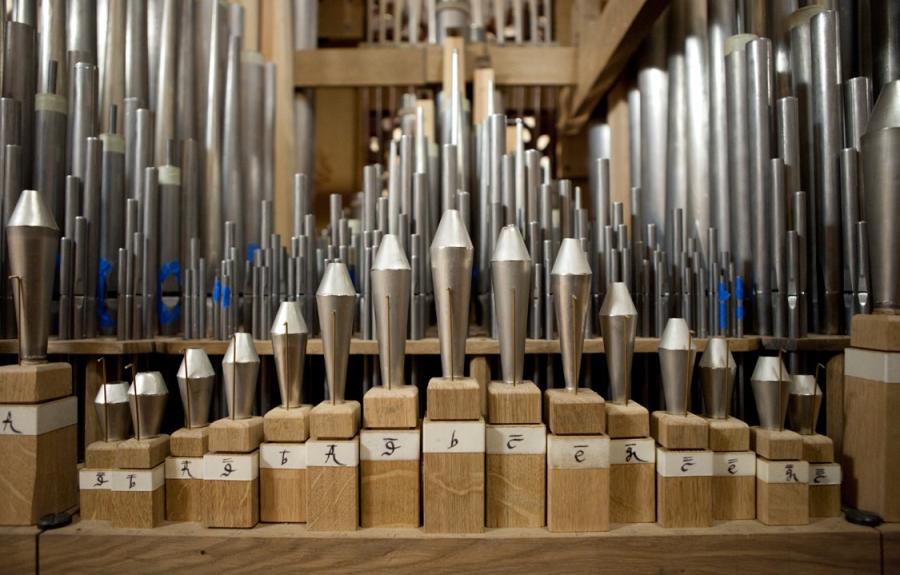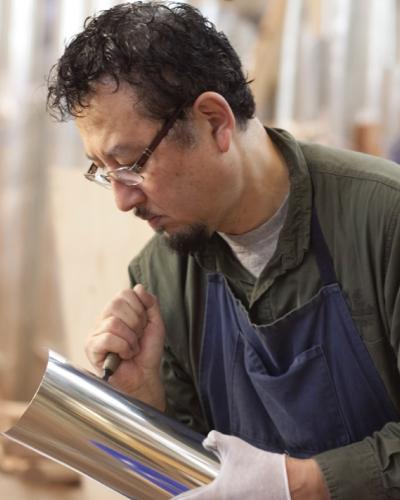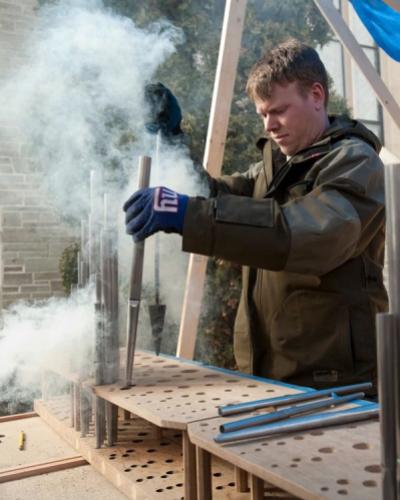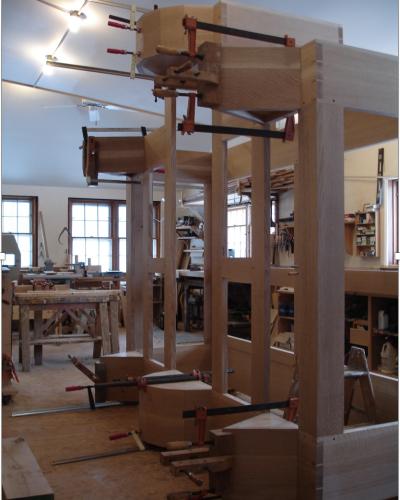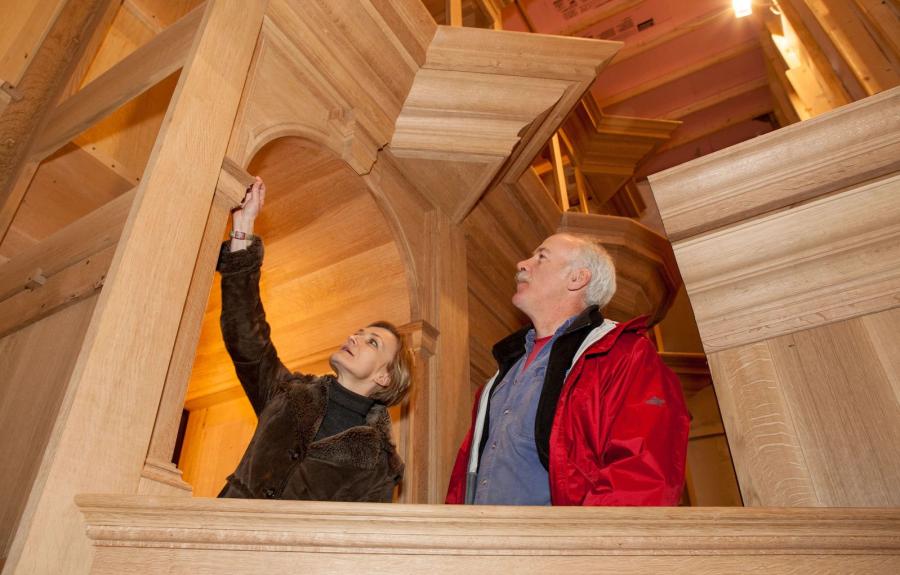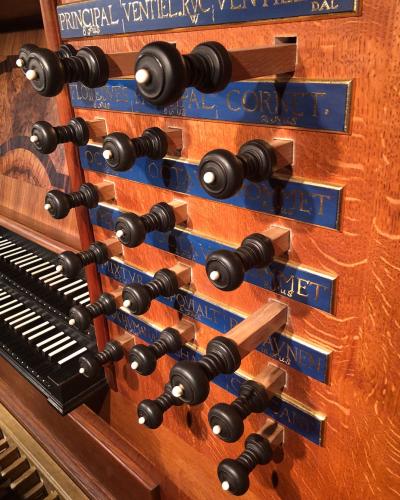The construction of the Cornell Baroque Organ was used as an opportunity to further research into organ building techniques in Arp Schnitger’s workshop in the early-18th century. Speaking in 2011 at the inauguration of the organ, Anette Schwartz, then Chair of German Studies, noted the organ was symptomatic of Cornell’s willingness to engage in innovative research and international collaborations. Read on here to learn about pipe construction techniques and questions of metal corrosion in historic instruments, the nuances of case construction, the organ’s innovative wind system, and questions raised by the decoration and design of Cornell’s modern old organ.
Pipes: Casting and Corrosion
From the casting of metal sheets to the cutting, rolling, and soldering of the pipes, all aspects were constructed strictly using the practices of builders working in late-17th century North Germany. Munetaka Yokota’s research into historic methods for pipe casting resulted in the unique sound of the Baroque organ. Casting the sheets of lead on a fine sand cools the metal faster, resulting in pipes with a different crystal structure and sound than those cast with modern techniques. The ratio of lead to tin in the pipes was itself carefully curated by Yokota to reproduce the tonal quality of Schnitger’s work. This lead-tin alloy is itself closer to the “pure” lead used by 18th-century builders; attempts in the 1970s to reproduce Baroque organ sound using pure lead, believed to be 18th-century practice for pipe casting, resulted in pipes that were too pure, and thus too soft. The more tin content in the pipes, the shinier the final finish can be: done by machine for modern pipes, but for the Baroque Organ the finish was scraped by hand. As Yokota noted at the time, “It’s an extremely time-consuming process that requires experienced hands… the pipe wall thicknesses have been hand-adjusted in order to obtain the best physical and acoustical properties for each pipe.”
Once the pipes were cast and in situ, Yokota took over seven months to voice the organ, ensuring each pipe has the correct volume and timbre and responds correctly to the pressure and speed of the performer’s touch. Upon discovering that the acoustics in Anabel Taylor tended to accentuate very high pitches––producing high frequency noise that is “too strong and destructive to our ear”––Yokota worked to make fine adjustments that reduced the sound of these higher partials and overtones but maintained the lively, extravagant character of the organ.
Pipe corrosion has been a problem for organ builders from the instrument’s earliest days. Cornell and its Baroque Organ also played a part in GOArt’s COLLAPSE project led by engineer Carl Johan Bergsten, which worked to identify sources of pipe corrosion. Surprisingly, scientists discovered that industrial pollution was not to blame, as previously suspected, but materials used in the construction of the organs themselves. The culprit is the acid released from the wood in the organ, which can cause corrosion not only through direct contact between wood and pipe, but also through becoming airborne, passing through the wind system and becoming concentrated in the pipes. High humidity quickens the corrosive process. As a post-doc at Cornell, Catherine Oertel, now Professor of Chemistry at Oberlin College, collaborated with corrosion chemists at the Chalmers University of Technology in Gothenburg to study how different compositions of metal alloys affect corrosion rates. Using high-power microscopes in Cornell’s nanofabrication facilities, Oertel found that even a small amount of added tin can reduce the susceptibility of pipes to corrosion, and that this protective effect is extremely sensitive to humidity. Ironically, modern glue (PVA or white glue) also releases acetic acid, and so the use of organic hide glue in the bellows and wind chest of the Baroque Organ, following historic practice, also helps to prevent corrosion. Modern organ builders also use plywood over oak, since the latter releases acidic gases that cause corrosion. In Schnitger’s day, oak logs were transported by water, a process that leached out the corrosive gases. As logs are no longer handled in this way, Yokota instead sealed the gases into the oak by charring the places where wood and pipe metal meet.
The wind, “which is the soul of the organ.”
The Baroque Organ does not have a single wind system, but was designed by Munetaka Yokota to have multiple different historic wind systems. Manual adjustments to wind channels allow for the recreation of wind systems from the 15th to early-19th centuries from North and Central Germany. The differences in stability and response to key action produced by the instrument––such that the organ truly “breathes”––encourage reflection on the part of the organist. Yokota’s ingenious system uses seven valves and eighty new feet of conductors, and permits study of the behavior of different wind systems within a single organ.
As part of this, the organ has also been measured as part of a larger GOArt study exploring the interactions between bellows, wind chest, key, pallet, and pipe. Carl Johan Bergsten, research engineer at GOArt, used sensors in the Rückpositiv, Hauptwerk, Pedal, and Bellows to measure the pressure and dynamic behavior of the wind system, in addition to sound measurements taken near the pipes and from the floor of the chapel. Combined, this data was designed to create a “fingerprint” of the organ’s wind system, allowing for comparisons across different instruments. As Bergsten noted, the wind pressure of an organ needs to be responsive: “You want to hear that the organ is breathing, but if it’s too much it starts to sound nervous, and can be destructive to the organ sound.” Bergsten was interested too in the sensitivity of pipes to wind, particularly since pipes such as those in the Baroque organ are more stable than those made using modern construction methods. Ultimately, his measurements reflect the decisions made by the organist at the console as they release chords and close the pallets.
How the bellows work on the Baroque Organ
Case Design: Of Carvings and Colors
The organ case was created by local woodworker Christopher Lowe. An expert cabinet maker, Lowe had never worked on something of this magnitude before: “It was a challenge just to get my mind around the scale of it… but I realized there was nothing that I didn’t know how to do, I just had to be ready to do a lot of it.” Most of the wood used in the organ is quarter-sawn domestic white oak from the Ohio River Valley, but Lowe could not find oak domestically that was long enough for the eighteen-foot long pedal tower frames, or the main timbers beside the keyboard; this came instead from a German forest that has been sustainably harvested for over 300 years. The big timbers for the balcony frame and bellows frame are recycled timbers from old mill buildings.
Challenges in the building came from unexpected places, as Lowe describes: “The tolerances are really tight. We worked to about a thirty-second of an inch for all of our work, but that’s on a scale of twenty-five feet… The points and polygons presented interesting geometric conundrums; not only the cutting of the joints, but the gluing up of those. One of the things people don’t realize about putting furniture and cabinets together is that the clamping of the gluing joints is quite an art in itself. For some pieces there’d be just a forest of clamps trying to push these things into place and hold them.” All the nails used for the project were hand-forged in Sweden. Lowe recalled that it “took us a little while to get used to the aesthetic. You’re used to seeing the nail head holding something on, but in this case we would nail from the back and penetrate the surface, and then clench over the nail itself. It ends up looking like a staple but it’s a rod iron nail.” Finally, the wooden surfaces were stained with caput mortem, a red pigment in linseed oil, and found just ten miles away in Trumansburg, NY. This natural stain matched the color of the balcony wood. Prior to staining, Lowe put a layer of wax over the entire surface of the organ.
The case itself is modelled after Schnitger’s instrument in Clausthal-Zellerfeld, built in 1702, and with a similar specification to the Charlottenburg organ. This case had nearly a hundred pieces of very elaborate, deep carvings that probably took a team of workers several years to complete, but Schnitger also sometimes used trompe l’oeil painting on flat pipe shades, as found on the Cornell Baroque Organ. GOArt researcher Joel Speerstra masterminded these designs, creating them from images of the original pipe shades in Clausthal Zellerfeld. In order to ensure the shades would blend with the natural variations of yellow and red in the oak grain, Speerstra’s collaborator Karen Speerstra had the two main colors in the case wood digitally analyzed and copied. Once Chris Lowe had built and prepared the pipe shades, Joel and Karen painted them with an undercoating of yellow with an overcoat of reddish brown, and combed the surface to look like wood grain while still wet. This produced oak frames for the pipe shades, and then the two colors were also used as a basic palette for the trompe l’oeil leaves and flowers.
The striking blue labels at the console also required some detective work. Researchers knew from documentation that the Charlottenburg organ had blue labels for the stop names, but it was unclear which blue, or why this unusual color had been chosen. Using black and white photographs, Joel Speerstra analyzed the density of gray in the photographs to determine the pigment, concluding that the color was not cobalt, which washes out in black and white, but must have been Prussian blue, newly discovered at the time of the Charlottenburg organ’s creation.
One of the most striking elements of Schnitger’s cases is the sculpture, and sculptor Todd McGrain, formerly Associate Professor of Art at Cornell, was keen to consider the possibility of including sculpture on the Cornell organ, noting that this is typically left out of modern organ design. One idea proposed by McGrain was the use of cherubs to unify the case, but he also sought to be inspired by Cornell “as a place with such a beautiful breadth of expertise and interest.” Any sculptures for the Baroque Organ should “point toward the broad palette of both academic and artistic endeavors that are part of what make Cornell such a wonderful place… appropriate for an institution that’s about nurturing the questioning mind.” Without funding, possible sculptures remain only a pipedream, although McGrain was also inspired by the finished design: “the somewhat understated, limited relief pipe shades has got me thinking that a more modern interpretation of sculptural elements for the organ might be more appropriate.”
Inaugural Festivities
Click here to learn more about inaugural festivities surrounding the Baroque Organ.

